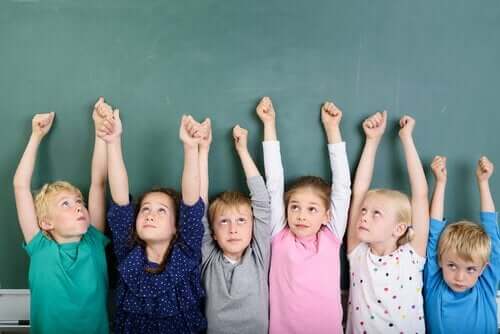Equality and Equity: Explaining the Difference to Children

At present, attempts are being made to give equal or fair treatment to vulnerable groups in society. This is the order of the day so that children grow up hearing these terms. But do they really know what they mean? In this article, we’ll talk about how to explain the difference between equality and equity to the children.
It’s important to note that the two concepts are very similar. In fact, it’s common for people to mistake them for synonyms. But, although equality and equity are closely related, their definition includes certain nuances that make these two terms very different.
Explaining the difference between equality and equity: Two definitions
To correctly explain to children the difference between equality and equity, it’s first necessary to know the definition of each of these concepts:
Equality refers to the act of providing all people with a series of similar opportunities, goods and resources to carry out certain activities so that everyone can enjoy them:
- Rights.
- Obligations.
- Conditions.
- Responsibilities.

- Equity is a term that implies justice (giving everyone what is theirs) and equality. Therefore, it encompasses the above. But, unlike equality, equity starts with what one needs and focuses on:
- The differences between people.
- The different social classes and economic levels.
Thus, one can say that, equality:
- Gives everyone the same resources.
- Is based on integration.
While equity has the following characteristics:
- Recognizes and accepts diversity.
- Avoids discrimination.
- Is based on inclusion.
“The first obligation of equality is equity.
– Victor Hugo –
How do you explain the difference between equality and equity to children?
Explaining the difference between equality and equity to children is very simple, you just need a good graphic and visual example. In fact, for some years now, there has been a very useful image circulating on the internet for this purpose.
This image features three people of different heights (an adult, a medium-sized child, and a small child), who are trying to watch a baseball game behind a fence. Thus, this drawing presents two scenarios:
- A scenario that represents equality: We can see how the three people have the same resources and opportunities to enjoy the game, since each one of them can climb onto a box to try to see over the fence. The problem is that, in this case, their individual size isn’t taken into account. Thus, the young child is unable to enjoy the game the same way as the other two since he still can’t see over the fence. At the same time, the medium-sized child can watch the game without difficulty while standing on the box, and the adult can see just fine even without the box.

- Another scenario that represents equity: Here, we see a similar situation to the previous one. But, in this case, each person has the number of boxes necessary to enjoy the game. So, the adult doesn’t need any box, the medium child uses one box, and the small child climbs on two boxes. In other words, everyone ends up at the same level, receiving fair treatment according to their needs.
What do children learn from this graphic example?
By observing this graphic example, children can reflect on the differences between equality and equity. But they also learn that each person is different and that there may be some children who require more support and help to achieve certain goals. And, at the same time, there are others who need less.
Therefore, with this explanation, children understand that everyone must be treated equally, without discrimination by sex, race, sexual orientation, disability, or any other reason.
At present, attempts are being made to give equal or fair treatment to vulnerable groups in society. This is the order of the day so that children grow up hearing these terms. But do they really know what they mean? In this article, we’ll talk about how to explain the difference between equality and equity to the children.
It’s important to note that the two concepts are very similar. In fact, it’s common for people to mistake them for synonyms. But, although equality and equity are closely related, their definition includes certain nuances that make these two terms very different.
Explaining the difference between equality and equity: Two definitions
To correctly explain to children the difference between equality and equity, it’s first necessary to know the definition of each of these concepts:
Equality refers to the act of providing all people with a series of similar opportunities, goods and resources to carry out certain activities so that everyone can enjoy them:
- Rights.
- Obligations.
- Conditions.
- Responsibilities.

- Equity is a term that implies justice (giving everyone what is theirs) and equality. Therefore, it encompasses the above. But, unlike equality, equity starts with what one needs and focuses on:
- The differences between people.
- The different social classes and economic levels.
Thus, one can say that, equality:
- Gives everyone the same resources.
- Is based on integration.
While equity has the following characteristics:
- Recognizes and accepts diversity.
- Avoids discrimination.
- Is based on inclusion.
“The first obligation of equality is equity.
– Victor Hugo –
How do you explain the difference between equality and equity to children?
Explaining the difference between equality and equity to children is very simple, you just need a good graphic and visual example. In fact, for some years now, there has been a very useful image circulating on the internet for this purpose.
This image features three people of different heights (an adult, a medium-sized child, and a small child), who are trying to watch a baseball game behind a fence. Thus, this drawing presents two scenarios:
- A scenario that represents equality: We can see how the three people have the same resources and opportunities to enjoy the game, since each one of them can climb onto a box to try to see over the fence. The problem is that, in this case, their individual size isn’t taken into account. Thus, the young child is unable to enjoy the game the same way as the other two since he still can’t see over the fence. At the same time, the medium-sized child can watch the game without difficulty while standing on the box, and the adult can see just fine even without the box.

- Another scenario that represents equity: Here, we see a similar situation to the previous one. But, in this case, each person has the number of boxes necessary to enjoy the game. So, the adult doesn’t need any box, the medium child uses one box, and the small child climbs on two boxes. In other words, everyone ends up at the same level, receiving fair treatment according to their needs.
What do children learn from this graphic example?
By observing this graphic example, children can reflect on the differences between equality and equity. But they also learn that each person is different and that there may be some children who require more support and help to achieve certain goals. And, at the same time, there are others who need less.
Therefore, with this explanation, children understand that everyone must be treated equally, without discrimination by sex, race, sexual orientation, disability, or any other reason.
All cited sources were thoroughly reviewed by our team to ensure their quality, reliability, currency, and validity. The bibliography of this article was considered reliable and of academic or scientific accuracy.
- Arenas, G. V., & Gaviria, J. A. T. (2010). La igualdad y la equidad: dos conceptos clave en la agenda de trabajo de los profesionales de la familia. CONTENIDO/CONTENTS, 98. http://biblioteca.clacso.edu.ar/Colombia/juridicasysoc-uc/20190206080733/Rlef2_completa.pdf#page=99
- Domínguez, J. F. M. (1978). La teoría del intercambio social desde la perspectiva de Blau. Reis, (4), 129-146. https://dialnet.unirioja.es/descarga/articulo/665741.pdf
- Murguialday, C. y Cristina Maoño, C. (2000). Igualdad de Género. Diccionario de Acción Humanitaria y Cooperación al Desarrollo. España: Icaria y Hegoa.
This text is provided for informational purposes only and does not replace consultation with a professional. If in doubt, consult your specialist.








